Grodno Hussars against falsifiers
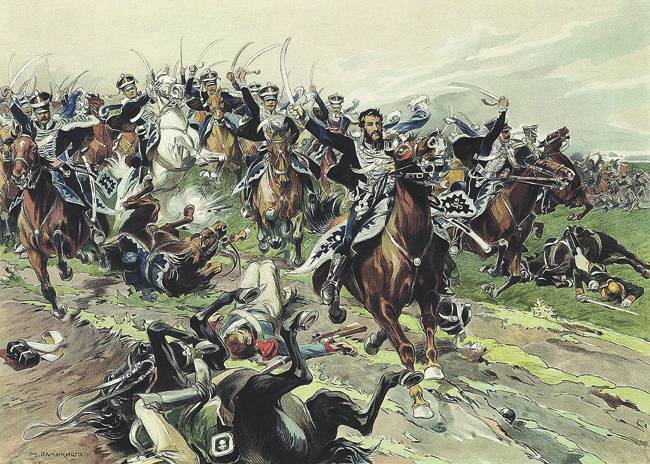
EXPLOIT KULNEVA
It is no secret that external forces, using local nationalists, seek to tear off history Belarus from the history of Russia. This year, on which the 150 anniversary of the Polish insurrection 1863 of the year falls, one of the priorities of the anti-Russian propaganda in the territories west of Smolensk is to turn it into a symbol of Polish-Lithuanian-Belarusian unity based on Russophobia.
A kind of ideological bogey, which helps to identify the "accursed tsarism" with the current Russia. And not so much in propolsky, as in the anti-Russian vein. This is done Jesuitly mean, with characteristic omissions and silencing the truth about the events, which even contemporaries called the "bloody fucker."
At the same time, 18 August turned exactly 150 years to one of the heroic episodes of this event, which later became a “textbook” example of courage for the soldiers of the Russian Imperial Army (and for the same reason literally erased from the historical memory after 1917).
Speech about the battle of the 42 of the Xenmus of Russian soldiers against more than 40-fold (!) Superior forces of the rebels. The officers of the Belarusian Grodno Hussars, which will be discussed below, commanded this small detachment of heroes.
The Grodno hussars called in the Russian army the soldiers of two cavalry regiments glorified in numerous battles and battles. The name and the emblem of the ancient Belarusian city first appeared on the banner of a hussar regiment, originally formed from Izyumsky, Alexandria, Sumy and Olviapolsky squadrons in June 1806 of the year. According to the decree of Emperor Alexander I, the regiment had to "consist until the command of the 5 squadrons."
Very little time passed, and the regiment received a baptism of fire in fierce battles with the army of Napoleon. Dashing hussars from Grodno are always ahead - in the most dangerous places of battles and fights. The regiment under the command of Major Yakov Kulnev (the future legendary hero of World War 1812) was invariably at the forefront of the army.
In the battle of Gutstadt, the dashing cavalry attacks of the Grodno residents made a significant contribution to the victory, as evidenced by the emperor's personal rescript. In the battles of Königsberg, Lykendorf and Friedland, the hussars headed by their commander so many times showed examples of extraordinary stamina, courage and courage that the enemies respectfully began to distinguish them from other parts of the army, nicknamed "blue hussars" for the color of mentika.
In the battle of Friedland, after the command of the mistakes of the regiment was surrounded by the French and almost captivated or destroyed, Kulnev personally led his cavalrymen. In a seemingly hopeless attack, several dozen horsemen broke into the enemy's thick orders.
This rush inspired the rest, already almost completely lost hope of warriors. With new forces rushing to the enemy, they broke through the ranks of the French. This feat commander of the Grodno hussars, for which he was awarded the Order of St.. Anna 2 degree, became known throughout the army.
ON SWEDISH BEACH
We did not have time to calm down the battles of this campaign, as Sweden, taking advantage of the temporary difficulties of Russia, tried to take revenge for the wars lost in the past. The Grodno Hussar Regiment was transferred to the north to Finland, where as part of the corps of General Peter Ivanovich Bagration (later the famous hero of World War 1812) he took part in the Russian-Swedish war.
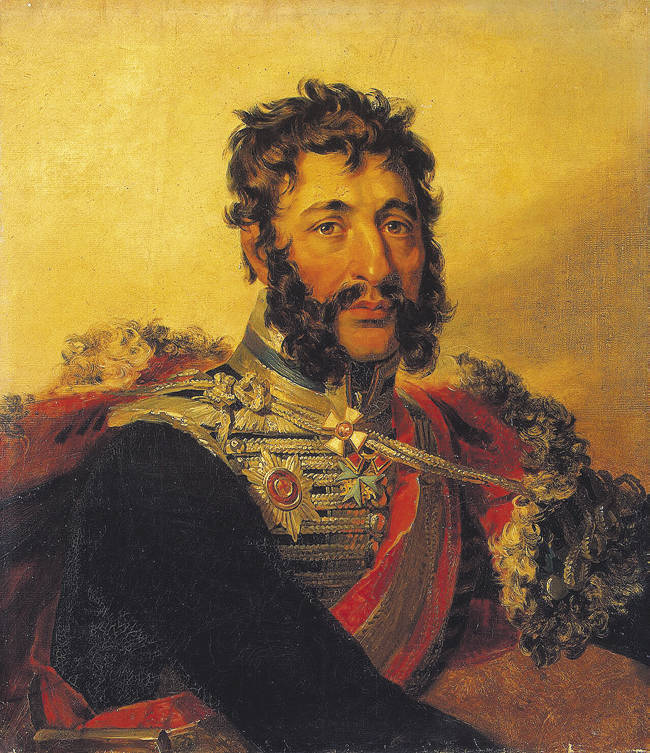
At that time, one of the regiment squadrons was under the leadership of the famous poet and future partisan Denis Davydov. The regiment itself was still commanded by Yakov Petrovich Kulnev. His nobility, courage and generosity to the vanquished aroused admiration and respect not only among friends, but also among enemies. Things reached the point that the king of Sweden issued a special decree that he forbade his soldiers to shoot at Kulnev!
For the first time in the history of wars in the harshest winter conditions, Russian troops, over the ice of the Baltic Sea, approached the shores of Sweden and occupied the Aland Islands. Then again go over the ice and raid in the direction of Stockholm, carried out on the night of March 7 1809.
At dawn, the Grodno cavalrymen seized the city of Grisselgam, almost a hundred kilometers from the Swedish capital, almost without a fight. Among the Swedes, who learned that the Russians were almost under the walls of their capital, panic began. Urgently staging a palace coup, they quickly requested peace.
The Russian army returned with another victory, and the mentics of many officers of the Grodno Hussars regiment decorated the military orders, and all the soldiers and noncommissioned officers were awarded a specially approved silver medal with the inscription "For the transition to the Swedish coast 1809".
TROUBLE WITH NAPOLEON
Less than two years after the end of the victorious war with the Swedes, the Grodno Hussars regiment again participated in the battles. This time with carriers of "two languages" - in the battles of the Patriotic War 1812 of the year. And again in the heat of the moment. Together with the whole army in the first days of the war, the regiment retreated to the east. But retreating, fighting off and counterattacking.
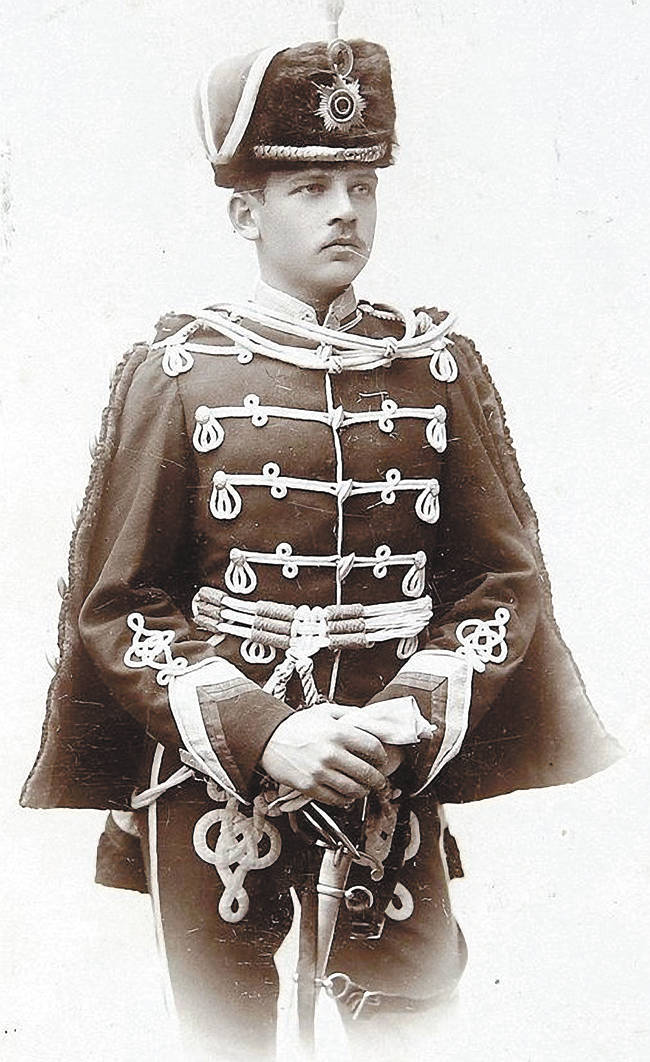
The organizer of the hostilities was the chief of the Grodno hussars and at the same time the commander of the rearguard of the 1 corps of the 1 of the Russian army Kulnev. Major General Yakov Petrovich, who by that time, along with his warriors, "waking up for all," proved himself, according to historians, "to be an incomparable commander and provided invaluable services to the army."
The French sought to cut off the Russian rearguard from the main forces. At the end of June, the 28-thousandth corps of Marshal Oudinot caught up with him at Vilkamir and imposed a battle. Despite the fact that the French threw huge forces against him, the detachment of Kulnev repulsed all the attacks and managed to join his own. It was the first victory in that war, which demonstrated that the French, who seemed so invincible until that time, can and should be beaten.
This is exactly what the Grodno Hussars did. And brilliantly. Under Druya, the regiment utterly routed the French brigade Saint-Genet. Near Polotsk captured many prisoners (several battalions and two squadrons) and guns. Near Klyastitsy, dashing cavalrymen fought the hardest three-day battle with superior enemy forces, preventing the French from moving to the capital of the empire St. Petersburg and once again covering the banner of the regiment with glory.
During the war with Napoleon, the Grodno Hussars took part in thirty general battles and fifty avant-garde battles. Five generals, 117 officers and more than 13 thousands of lower ranks of the enemy army were taken prisoner.
The regiment banner darkened in the powder smoke of battles fluttered proudly in the battles of Bautzen, Fershampuneaz, Reims, and many other cities in Europe. Below him, the hussars from the city over the Neman 20 February 1813, entered Berlin. And again, being in the forefront, the regiment stormed Paris, and then joined it.
Seven silver pipes - honorary awards for military units - with inscriptions reminiscent of the battles of those years, the Grodno Hussars from the fields of these glorious battles brought the honorary badge to the headgear. Many officers were awarded orders and honorary weapons, and the regiment soldiers received 437 crosses of St. George! This highest soldier's award was very highly valued at that time, it was given extremely rarely and only by the most courageous and brave.
PEN AND SABER LERMONTOV
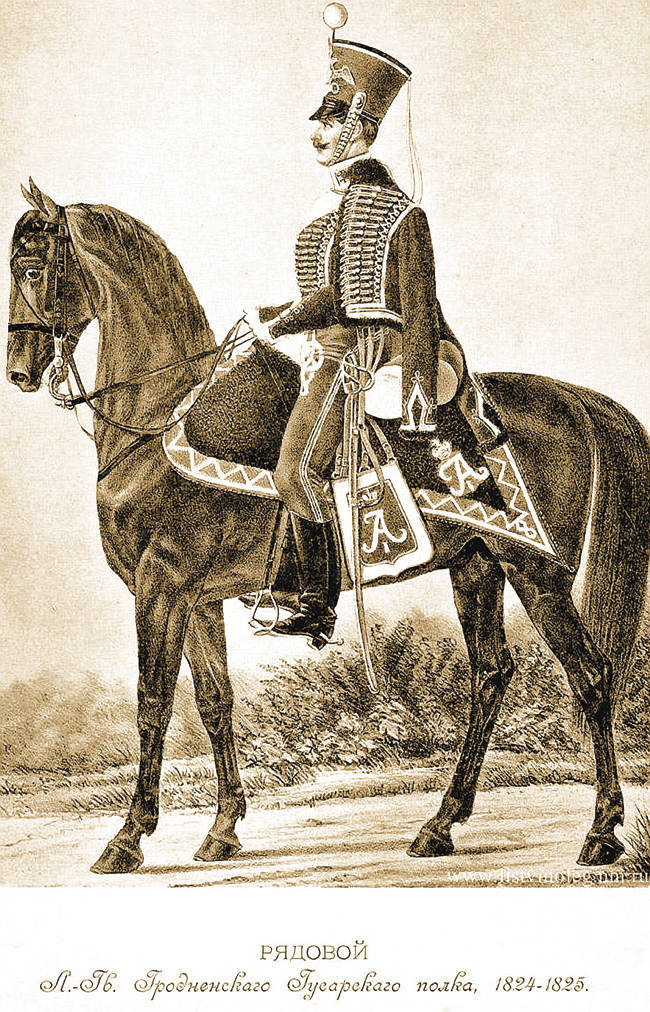
In 1824, the regiment was given a new name in memory of the famous Klyastitsky battle. He began to be called Klyastitsky hussarsky, subsequently Klyastitsky dragoons. Despite this, the name of ancient Grodno did not disappear from the battle hussar flags.
19 February 1824 in the town of Sedlec from the people of the former Rzecz Pospolita, who were in the regiments of the 1, 2 and 3 of the Hussars and the Lithuanian Ulan divisions, was formed as a young guard, already guards, in the cavalry regiment ( 4-x squadrons with a walking reserve). He received the name of the Life Guards Grodno Hussars.
The continuity of the glorious traditions and honor surrounding the regiment's name is evidenced, for example, by the fact that not only the grand dukes of the Romanovs, but even the Russian autocrats Alexander II, Alexander III and Nikolai II themselves were listed on the regiment lists!
As contemporaries wrote, a bright meteor in the life of the Grodno hussars was flashed by the poet Mikhail Lermontov who was transferred to the regiment in October 1837. It was in the Grodno Hussars, where the future classic of Russian and world literature served until March 1838, he wrote the main edition of "The Demon". Here, Mikhail Yuryevich worked on "The Hero of Our Time", painted the paintings "Circassian", "Memories of the Caucasus".
TURKISH CAMPAIGN
Meanwhile, the military service of the Grodno hussars continued. Dashing cavalrymen emerged victorious from all fights with Polish rebels in 1831 year. And now, under the horses' hoofs - Warsaw! And the haughty pans, who boldly cut out only Russian prisoners, just smile ingratiatingly, watching their puns “present engagement” to the handsome cavalrymen.
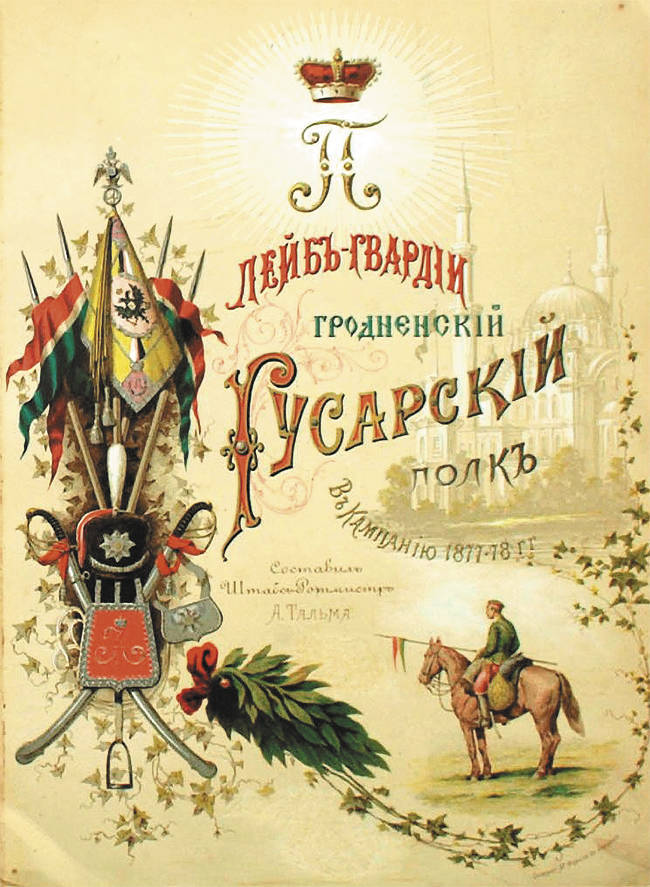
6 December 1831 of the Year “to commemorate the exploits of excellent courage in the continuation of the war with the Polish rebels”, the regiment was granted the rights and advantages of the Old Guard.
In 1854-1855's, the regiment marched to Finland, stood outpost against the Anglo-French troops during the Crimean War.
During the war with the Turks for the liberation of the Balkan Slavs, the Grodno hussars again covered their banners with glory. Having crossed the Danube in the very first days of the war, the Grodno fighters participated in the avant-garde battles near Adrianople, Rhodesna, Gorniy Dubnyak, the assault of Philippopol, fought at Plevna, seized Telishi fortified position.
Interestingly, the national hero of the Russian and Bulgarian peoples who covered himself with unfading glory in that war, the outstanding commander Mikhail Dmitrievich Skobelev, began his military service in the Life Guards Grodno Hussars (where he was eager to excel in the Polish insurgents, He was transferred according to his request in 1864 year).
At the end of 1877, the hussars of the regiment, under the joyful cries of the Bulgarian “little brothers”, were the first to enter liberated Sofia under the command of the commander of that war, General Iosif Vladimirovich Romeyko-Gurko (born in White Russia).
Then again fierce battles with the forces of Suleiman Pasha, in which the Turks were finally defeated. For deeds, courage and bravery, the Grodno hussars of the regiment received the St. George standard of honor with the inscription "For the difference in the Turkish war 1877 and 1878's."
LAST NICE TAKE OFF
In 1882, almost all of the hussar army regiments of the Russian Empire were renamed Dragoons. By the beginning of the 20th century, only two of the best of the best guards hussar regiments remained in Russia: His Majesty’s Life Guards and the Grodno Life Guards.
Grodno Hussars participated in the First World War. Their banners and bravery instilled fear in the enemy in the Battle of Galicia, the Lublin, Warsaw-Ivangorod, Czestochowa-Krakow and Vladimir-Volyn operations.
Unfortunately, after the victory of the Soviet power, the regiment was left in Gzhatsk, where its “Ukrainization” began, which led to the fact that the Grodno hussars were tried to be turned into the “Hetman Sahaidachny regiment”.
The “sagaidachniki” sent by train from Gzhatsk to Kiev were stopped by the Red Guards along the road from Orsha to Mogilev, disarmed and dispersed to their homes. The regiment itself was officially disbanded on March 4 of 1918 by order No. 236 of the Moscow Regional Commissariat for Military Affairs.
The Grodno-based Hussars left without a regiment from 27 in May 1919 of the year (according to researcher S. Volkov) became part of the Combined-Hussar Regiment formed in the White Army, where in July 1919 were represented by a squadron.
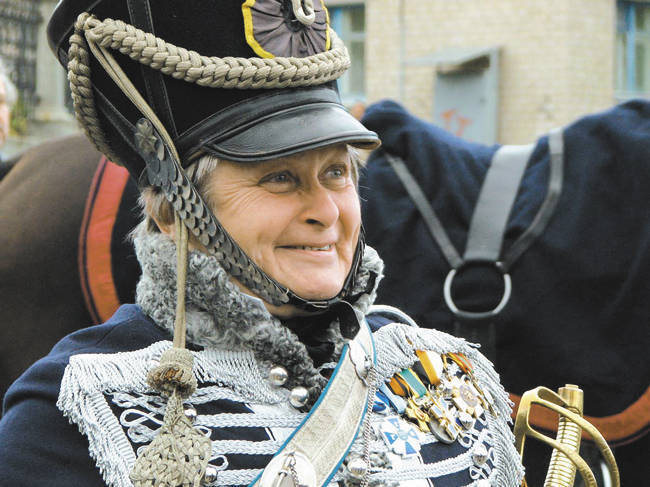
From 30 December 1919, the regiment squad was part of the Consolidated Cavalry Brigade, from the beginning of January 1920 of the year to the Combined Guards Cavalry Regiment of the 1 Cavalry Division, after arriving in Crimea, from 16 on April 1920 of the year, finished with a report to a resignation of a squadron. cavalry regiment.
The regiment lost nine officers in the White Movement (three were shot, three were killed and three died of illness). The regimental association in exile (Paris) for 1951 year consisted of twenty people.
... Today, Polish propaganda under the patronage of President B. Komorowski personally uses the myth of patriotic dedication and gentry sacrifice of 150-year-old rebels and other small members of Russophobian actions, without bothering with concrete details.
Those who follow this mythology in Belorussia also do not say anything about real, and not invented, gentry heroism and the sacrifice of many thousands of sons of White and Little Russia, who have devoted their lives to serving the Fatherland - faithfully!
Information